A Multidimensional And Multi Material Approach To Using Stem Cells
- 17 Mar 2017
- Volume 9
- NanoScientific Magazine, Winter 2017
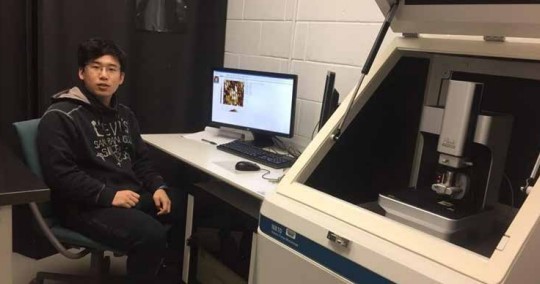
Hyeon-Yeol Cho, Post Doc student at Rutgers University where is currently studying stem cell engineering. He is pictured here in front of the Park Systems NX 10 Atomic Force Microscope used in the lab. The KiBum Lee group where he works is focused on unlocking the secrets to stem cell research.
Can you explain more about your research studying stem cells to regenerate cells and grow new tissue?
Stem cells, as understood, have the ability to become any specialized cells capable of replacing damaged ones which from either injuries or degenerative diseases. However, the major drawback in stem cell therapy is the low efficiency in giving rise to these specialized cells. The KBLEE group focuses on tackling this issue from multidimensional and multimaterial approaches. Our approaches include: 1) soluble microenvironmental factors, 2) insoluble physical facts, and 3) Nano-topographical features. We believe that innovative approaches are the key to untangling the complexity associated with stem cells.
Can you describe how nanochemistry is currently being used in stem cell research?
The research area of nanochemistry includes small molecule assembles or nanoparticle synthesis. In order to use the nanoparticle's versatility, it is widely used to deliver various drug and oligomers which can initiate stem cell differentiation; plasmid, short RNAs, differentiation factors. Especially, gold nanoparticle is the representative material for stem cell research with its stability and easy surface modification.
What is gene expression and how is it used to advance stem cell research?
How does your research integrate nanotechnology with chemical biology to modulate signaling pathways in cancer and stem cells? Gene expression is where genotype gives rise to the phenotype, the realization of an end product from the instruction of a blueprint. Every cell in our body has genetic blueprint encoded inside our DNAs; hence, cells can decide on the time and duration of which they turn on/off those specific genes to make specific proteins. Therefore, through innovative integration of nanotechnology (nanomaterial and genetic material) our research can modulate cancer and stem cells at the DNA level upstream of varies biological cascades.
What is NanoScript and how does it interact with DNA for stem cell research?
Transcription factors are the master regulator of gene expression, and scientists have tried to deliver these factors in hope to alter gene expression for therapeutic reasons. However, to overcome the challenges associated with vial-vector based genetic material delivery, the KBLEE group has developed an innovative, tunable nanoparticle-based artificial transcription factor protein platform, NanoScript, to effectively and selectively regulating genes in a non-viral manner. The nanoparticle-based synthetic transcription factor (STF) platform emulates the fundamental functions of transcription factors, thereby allowing for regulating transcriptional activity (e.g. activation or repression) and targeting gene expression in both an effective and selective manner. Owing to the its modular design, NanoScript is an invaluable tool in stem cell research.

Dr. KiBum Lee (center) and his group at Rugers University aimed at unlocking the full therapeutic potential for stem cells. http://kblee.rutgers.edu/
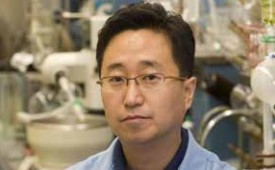
Dr. KiBum Lee
KiBum Lee is a professor of Chemistry and Chemical Biology at Rutgers University. The primary research interest of Dr. Lee’s group is to develop and integrate nanotechnologies and chemical functional genomics to modulate signaling pathways in stem cells towards specific cell lineages or behaviors. In particular, his group is exploring critical problems in cancer research and stem cell biology pertaining to the cellmicroenvironmental interactions, and how to control these interactions at the subcellular and single cell level using chemical biology and nanotechnology. From this research effort, he has developed innovative technology platforms that may overcome the critical barriers to harnessing the full therapeutic potential of stem cells. technology platforms that may overcome the critical barriers to harnessing the full therapeutic potential of stem cells.
Examples of AFM images from the Rutger research lab
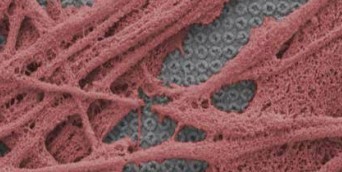
Pseudocolored image of dopaminergic neurons derived from hNSCs
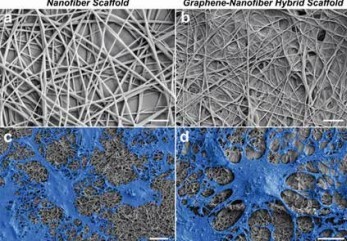
Morphology of nanofibrous scaffolds and cultured NSCs on the scaffolds
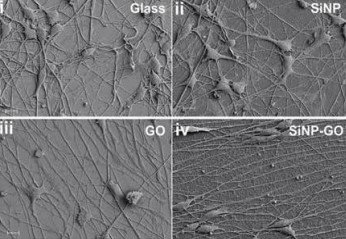
behavior of hNSCs on silica nanoparticle-graphene oxide
How do you increase the efficacy in substrates for transplanting stem cells into muscle tissue to counteract conditions such as Parkinson’s disease?
The musculoskeletal abnormality symptoms suffered by Parkinson’s disease patients is related to the unspecific dying of dopamine generating nerve cells, dopaminergic neurons, which has extremely limited regenerating ability. As mentioned before, stem cells hold the key to give rise to specific cells. In order to check with high sensitivity and selectivity, we have developed the LHONA substrate to detect the maturation of dopaminergic neuron from stem cell differentiation. This substrate platform is unique in the sense that it allows for live-cell detection contrary to conventional methods of DNA/RNA/protein harvesting and immunochemistry. Upon confirmation of mature
dopaminergicneuron differentiation using the LHONA substrate, dopaminergic neurons can then be transplanted into a Parkinson’s patient to cure the disease.
How do you use AFM in your research?
The AFM equipment has unique features to analyze the mechanical properties in nanoscale. We utilize AFM to confirm the unique nano-topographical features for bioapplications; large-scale homogeneous nanoarray, nanofiber sheet, hydrogel.

Hyeon-Yeol Cho, post doc student at Rutgers University, KiBum Lee group
Hyeon-Yeol Cho is a post doc student at Rutgers University where he works in the KiBum Lee group. He has been involved in research at the interface between nanotechnology and cell biology, since 2010 when he started doctoral and post-doctoral work at Sogang University and Rutgers (with Dr. Jeong-Woo Choi and Dr. KiBum Lee). His primary research interest is to develop and integrate nanotechnologies and cell biology to modulate signaling pathways in cells (e.g. stem cells and cancer cells) towards specific cell lineages or controlling their behavior and to monitor it noninvasively. His work is focused on two primary areas where he has published a number of papers as shown below.
Inorganic/organic nanoparticle for in vivo/vitro diagnosis and therapy
My main research interest is bio-inspired nanoparticle based approaches for cancer diagnosis/therapy and stem cell manipulation. By taking advantage of the nanoparticle’s unique physical properties and appropriate size for labeling and probing biological systems,I have developed bio-inspired nanoparticle-based novel method for detecting and isolating target cells.Towards the goal of probing the fundamental mechanism of cellular response with delivered nanoparticle in cancer and stem cells, I keep focusing on the development of functional bioinspired nanoparticles.
a. H. J. Lee*, H. -Y. Cho*, J. H. Oh, K. Namkoong, J. G. Lee, J. -M. Park, S. S. Lee, N. Huh, & J. -W. Choi, “Simultaneous capture and in situ analysis of circulating tumor cells using multiple hybrid nanoparticles”, Biosensors and Bioelectronics, 2013, 47, 508–514. *Equal Contribution
b. T. -H. Kim, H. -Y Cho, K. B. Lee, S. U. Kim, & J. -W. Choi, “Electrically controlled delivery of cargo into single human neural stem cell”, ACS Applied Materials and Interfaces, 2014, 6 (23), 20709-20716
c. W. A. El-Said, H. -Y. Cho, C. -H. Yea, & J. -W. Choi, “Synthesis of metal nanoparticles inside living human cells based on the intracellular formation process” Advanced Materials, 2014, 26(6), 910-918.
d. Md. K. Hossain*, H. -Y. Cho*, K. -J. Kim & J. -W. Choi, "In situ monitoring of doxorubicin release from biohybrid nanoparticles modified with antibody and cell-penetrating peptides in breast cancer cells using surface-enhanced Raman spectroscopy", Biosensors and Bioelectronics, 2015,71, 300-305. *Equal Contribution.
Modifications of cell-on-a-chip platform
This experience and knowledge supported to understand cellular response in drug treatment and stem cell differentiation using various functionalized substrate with nanopattern.Biomaterials (synthetic peptide and ECM molecules), organic materials (polymer, lipid, etc) and inorganic materials (metal nanostructures) can be applied to surface for improvement of biocompatibility and sensitivity of cellon-a-chip platform.
a. H. -Y. Cho, T. -H. Kim, E. -B Ko& J. -W. Choi, "Fabrication of carbon nanotubes/RGD peptide composites to enhance electrochemical performance of cell chip", Journal of Biomedical Nanotechnology, 2013, 9(8), 1398-1402.
b. E. -B. Ko, H. -Y. Cho, T. -H. Kim, C. -H. Yea & J. -W Choi, “Cell chip with a thiolated chitosan self-assembled monolayer to detect the effects of anticancer drugs on breast normal and cancer cells”, Colloids and Surface B: Biointerfaces, 2013, 112, 387-392.
c. H. -Y. Cho, T. -H. Kim, S. U. Kim, & J. -W. Choi, “Fabrication of stem cell chip with peptide nanopatterned layer to detect cytotoxicity of environmental toxicants”, Journal of Nanoscience and Nanotechnology, 2012, 12, 834-839.
